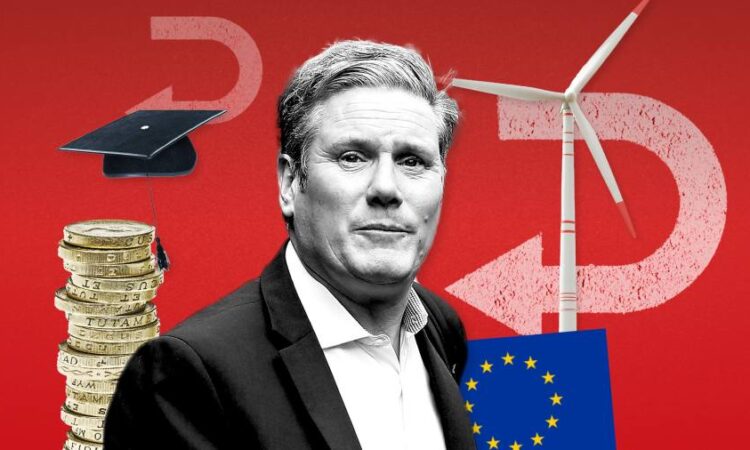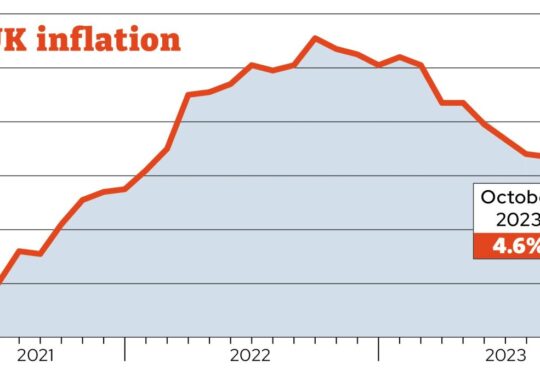
In the run-up to the UK general election, Labour leader Sir Keir Starmer is braced for repeated claims by his political opponents that he has “flip-flopped” and “U-turned” on countless policies.
Starmer is following a centre left political path similar to that of former Labour prime minister Sir Tony Blair, and this is reflected in how he has overhauled his reform agenda since becoming party leader in 2020.
There are a number of key policies where the Labour leadership has changed or reversed position as Starmer abandoned the “hard left” agenda of his predecessor Jeremy Corbyn. Below are five core examples.
Taxes
Last week shadow chancellor Rachel Reeves said Labour had “no plans for a wealth tax”, in a marked change of tone from previous comments made by the party leadership.
In 2018, when she was not a shadow minister, Reeves called for £20bn in annual wealth taxes. In 2021 she suggested it would be better to “tax people who get their income through wealth”, such as shares and buy-to-let properties.
Meanwhile, Starmer has dropped his pledge, made when he stood in the Labour leadership contest, to “increase income tax for the top 5 per cent of earners”.
Labour does have some tax plans that would hit the wealthy. For example, Reeves is committed to reversing the government’s move in the March Budget to scrap the £1mn lifetime allowance on tax free pension contributions.
Treasury minister Andrew Griffith accused Reeves of being “disingenuous” by claiming Labour had no plans for wealth taxes when it proposed to restore the lifetime allowance. “That is a wealth tax by another name,” he said.
A Labour official said Reeves’ recent statement on wealth taxes applied to future fiscal decisions, adding: “We do not have any plans to increase taxes outside of what we have already announced.”
University tuition fees
Starmer campaigned for the Labour leadership on a promise to abolish tuition fees and “end the national scandal of spiralling student debt”.
But at the start of this year he said he was putting the policy under review given it would cost £9.5bn a year, blaming the weak state of the public finances.
In May Starmer confirmed the U-turn, saying: “We are likely to move on from that commitment because we find ourselves in a different financial situation.
“But I don’t want that to be read as us accepting for a moment that the current system is fair or that it is working. We are looking at options for how we fund these fees.”
The National Union of Students said it was disappointed by the policy change and warned Labour could not take students’ votes for granted.
“The current system is broken, prioritising money over student welfare and education,” it added.
Industry nationalisations
Corbyn’s 2019 election manifesto vowed to take the “rail, mail, water and energy” industries into public ownership.
Starmer, in his bid to replace Corbyn, offered to “support common ownership of rail, mail, energy and water”.
But the Labour leader has since scaled back his commitment, with the party now only committed to nationalisation of the railways.
Contracts with rail operators to run different routes would only be brought back under state control gradually as they expire.
Matt Wrack, general secretary of the Fire Brigades Union, said Labour’s annual conference had repeatedly voted for a full reversal of “the great privatisation rip-off” under previous Tory governments.
The FBU will “support any attempt at Labour conference to commit a Keir Starmer-led government to return the privatised utilities to the public sector”, he added.
Green transition plan
The green plan is by far Starmer’s most expensive policy, involving a Labour government borrowing £28bn a year for measures to accelerate the UK transition to net zero carbon emissions by 2050.
The policy was devised when interest rates were close to zero, and in June, with borrowing costs much higher, Reeves scaled back the commitment by saying the £28bn annual figure would not be reached until halfway through the first term of a Labour government.
Reeves also confirmed the policy would have to meet Labour’s fiscal rule that public debt must be falling as a share of national income after five years.
Rebecca Newsom, head of politics at Greenpeace, said: “Rachel Reeves has rightly cited the opportunities of green growth, but Labour’s delay on confirming the scale of investment needed from the start of a new government risks throwing in the towel on the global race in green tech, with the US, China and the EU already far ahead.”
Brexit
Starmer was the key figure under Corbyn’s leadership who supported a second referendum on EU membership in his role as shadow Brexit secretary.
After Labour’s devastating defeat at the 2019 election, Starmer abandoned that position.
He stood for the party leadership promising to “defend free movement [of people] as we leave the EU”, but he has since ditched that stance.
Starmer has ruled out taking Britain back into the EU or the single market, but wants to improve the UK’s trading arrangements with the bloc.
Mike Galsworthy, chair of the anti-Brexit European Movement UK, said: “Starmer’s job now is to win a general election. If he wins, his job changes and he’ll have to deal with all the headaches that Brexit has created.
“As a new prime minister he wouldn’t be able to do his new job properly within the straitjacket of the hard Brexit he inherited.”
Labour has defended how Starmer has revised his reform agenda, including by dropping some of the radical pledges made during the party leadership contest.
Will Jennings, professor of political science at Southampton university, said Starmer was trying to build a “clear and credible” election offer that would not leave Labour vulnerable to Tory attacks.
“It’s understandable why people on the left feel disappointed about a lack of ambition,” he added.
“But this is like the US presidential model where you have to appeal to your own audience in the primaries then tack towards the general voter at election time.”






